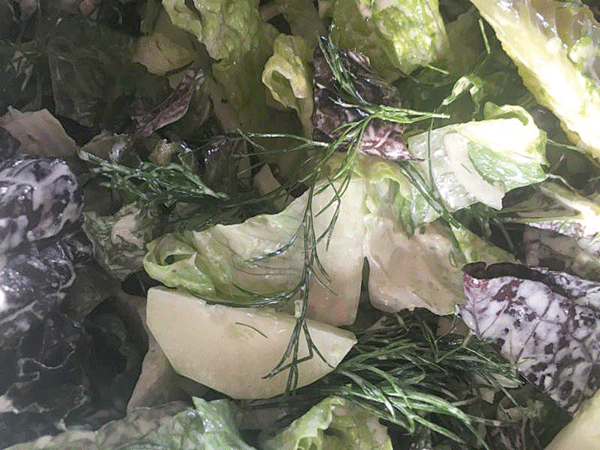News & Articles
Browse all content by date.

In summer, one could do worse than to eat like a vegetable farmer. While veggies are often labor intensive, famers have ways of preparing them quickly, because they have less time on their hands than you do. After years of exposure to their produce, growers have found the most efficient ways of preparing it in the most flattering of ways. When that food is romaine lettuce, the accompanying research has shown that the yummiest way to eat it is with Creamy. The proper noun, that is, short for creamy salad dressing.
On a certain farm that grows particularly good romaine lettuce, Creamy is a way of life. If you ask Luci, the matriarch of the farm, how she is doing, if things are going well she’ll say “We’re creamy.”
Despite any assumptions that a literal interpretation of the word “creamy” might inspire, this dressing does not contain actual cream. It can, if the Creamy maker is so inclined, contain dairy product like shredded parmesan cheese. When Luci makes Creamy for a midsummer salad topped with mutton, she replaces half the mayo with yogurt. So while certain milk-based products do show up in Creamy from time to time, they are certainly negotiable.
That cannot be said about the mayonnaise. To all the mayo haters out there, I suggest you call a truce, this time, like you would for tuna fish or potato salad. Mayo is not only the main ingredient in Creamy, but also its patron saint.
Like Creamy, mayo delivers a creamy flavor without the assistance of actual cream. And like mayo, Creamy is not a one-dimensional fat bomb but a nuanced presentation of fat, balanced with acids and other tastefully applied seasonings. Creamy is a luxurious and sparkling, if soupy, version of mayo itself, oozing into the cracks and gaps in the flavor of whatever it is applied to, and making your food taste whole. Better, even.
Like mayo, Creamy is a condiment for the people, descended from royal roots. Creamy is what happened when Caesar salad had a lovechild with a bottle of Ranch.
But for all its absolute perfection, Creamy is a shape-shifting sauce, as much process as product. It is a state of mind more than a recipe, but with that being said here are some basic parameters.
Creamy Ingredients
2-4 cloves fresh garlic, mashed with ½ teaspoon salt. This time of year you can use scapes instead of bulb garlic.
½ cup of lemon or lime juice and/or white vinegar like champagne or white balsamic. Experiment with different acids each time you make it. My current fav is lime with white balsamic.
2 tsp grated lemon zest (lime doesn’t zest as well, but it can work)
1 teaspoon each of dry mustard powder and Worcestershire sauce
½ cup mayo (or Vegenaise, which Luci and I both prefer)
About the same amount of olive oil.
Directions
Combine ingredients and mix until, as Luci puts it, “the texture pleases me.” Adjust seasonings, and toss into your favorite salad.
Notes on the directions
Again, this should be considered general guidance, very much open to interpretation based on the context and whatever special ingredients are available. When Luci makes basil Creamy, for example, she omits the Worcestershire sauce and mustard, so the flavor doesn’t get too busy. When I make Creamy I edge toward its Caesar side, incorporating anchovy paste, capers and lots of fresh ground black pepper.
As for the salad, in addition to the requisite romaine, it should contain sliced onions-preferably Walla Wallas-and cucumbers as well. It will taste a little naked without some fresh dill, or a combination of dill and cilantro, in the mix. Other garden goodies like peas or endive can be incorporated as well, but, as with its Caesarean forefather, it doesn’t need tomatoes. However, there is one reddish ingredient that does have a rightful place in the Creamy salad bowl: a piece of fresh salmon, broiled in olive oil, lemon and garlic.
I should note that Creamy is a thing, outside of Luci’s Romaine Lettuce farm. She hardly invented this dressing, nor would she take credit for it like she does at market for the romaine, which her husband actually grows. Recipes for creamy salad dressing abound, some of which are similar to some of Luci’s. There are internet comments sections filled with discussions on subjects like which Greek yogurts are the best mayo substitute, and other crazy talk. In any case, Luci got to where she is on the shoulders of Creamy giants, and we all could do worse than learn from how she’s customized Creamy to her needs.
In a recent phone conversation, Luci told me about how the acquisition of a submersible blending tool changed everything. “It turns everything to mayo,” she told me. “It’s revolutionized things around here.”
She now skips the mayo altogether and simply adds its precursors: egg, lemon juice and oil (a combination that, collectively, is known as mayonnaise). The result is a thick dressing to which she sometimes adds buttermilk or yogurt-both of which, in addition to cream, add tanginess, which augments the lemon juice and vinegar. Such redundancies create a diverse tapestry of flavor that will complete your salad, coating its leaves in rich umami zing.
And salad is hardly the only substrate for Creamy. Luci must contend with an endless parade of kids, parents, farm help, visitors, and other so-called random people who, if the coast is clear, will cross the kitchen, open the fridge, and scan for Creamy.
“When they see leftover Creamy in the fridge, they put in on bread or other stuff,” she says. “Or dip stuff in it. I frown on that.”
| Tweet |


